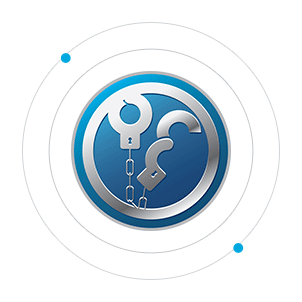Here Are The Most Notorious Phishing Attack Tactics
In today's hyper-connected digital age, cyber threats have expanded, ushering in a new era of sophisticated tactics that prey on human vulnerabilities. From phishing attacks to tips on how to stay safe online, we at Scam Detector try to offer you all the tools to find out if a third party is authentic, including our website validator.
Phishing is at the forefront of all the threats, a deceptive strategy fraudsters employ to trick individuals into divulging sensitive information. By understanding the intricacies of phishing attacks, we arm ourselves against the unseen dangers lurking in the digital shadows.
Scam Detectors Most Trusted Websites in Online Security
- Guard.io (100): Surf the web safely. Clean up your browser, remove maliscious extensions and check for privacy violations.
- Incogni.com (100): Delete your personal data from the internet and protect against scams and identity theft.
- ExpressVPN (100) Stay secure and anonymous online - Best VPN Out There
Here's a deep dive into the tactics of these cyber adversaries and how you can prevent falling victim.

The Anatomy of a Phishing Attack
Phishing doesn't merely rely on technical fraud; it's an art of deception, leveraging psychological manipulation to lure its victims into a false sense of security. Here are 19 key things you need to know about phishing attacks:
1. Crafting the Bait
Phishing emails mimic legitimate institutions, such as banks or popular online services. By using authentic logos, language, and even mimicking email addresses, fraudsters aim to make their bait indistinguishable from genuine communications.
2. Urgency and Fear
Many phishing emails instill a sense of urgency or fear. Statements like “Your account will be locked” or “Unauthorized login attempt detected” are designed to incite panic, pushing the victim to act hastily without questioning the request's legitimacy.
3. Concealed Links
These emails often contain links that, while appearing legitimate on the surface, redirect victims to malicious sites. These sites are carefully designed replicas of authentic websites, tricking users into entering their credentials or personal information.
4. Evolving Threat Landscape
It's not just emails. Phishing tactics have evolved, spreading to various platforms: audio, video, apps, etc.
5. Vishing (Voice Phishing)
Vishing, short for voice phishing, is a testament to fraudsters' adaptability and cunning. In this method, attackers use the telephone to play their deceptive game. Here's how they weave their treacherous narrative:
6. Impersonation
Vishing attackers excel at mimicking. They may claim to represent banks, tax agencies, or even tech support, presenting a scenario that prompts the victim to share sensitive details.
For example, they might alert the victim to suspicious transactions in their bank account.
7. Background Noise
To make the call sound authentic, background noise might mimic a call center. This noise serves to create an illusion of legitimacy.
8. Pressure Tactics
Like their email counterparts, vishing scammers often apply pressure, suggesting severe consequences if immediate action isn't taken. They might ask victims to verify their account details or make a payment to “clear up” a fabricated issue.
9. Call Spoofing
Advanced vishers use technology to mask their actual number, making it appear that the call comes from a trusted source. It's called Call Spoofing, but your probably have heard of it before.
10. Smishing (SMS Phishing)
As our reliance on smartphones grows, so does the threat landscape. Smishing is a method where the bait is set via text messages:
11. Trusted Platform
People often trust text messages more than emails, making smishing an effective phishing tactic.
12. Urgent Action Required
Similar to email-based phishing, smishing often carries messages that demand immediate action. Messages may say that the user has won a contest, a package is waiting for delivery, or a bank account is about to be locked.
13. Malicious Links
A hallmark of smishing is the inclusion of short, often obfuscated links. When clicked, these lead users to fraudulent websites where personal data can be harvested.
14. Direct Requests
Some smishing attempts might brazenly ask users to reply to the text with personal information.
15. Spear Phishing
While traditional phishing casts a wide net, hoping to trap any unsuspecting individual, spear phishing is a targeted strike.
16. Customized Lures
Attackers spend time researching their victim, using details from social media, public records, or other sources. This helps them craft emails that resonate more deeply, referencing actual events, mutual acquaintances, or shared interests.
17. Positional Targeting
Often, spear-phishers target individuals in specific roles within organizations. For instance, someone in finance might receive a seemingly internal request for fund transfers.
18. Attachment Ploys
Unlike broader phishing attempts, spear phishing emails might contain attachments relevant to the victim's job or personal life, increasing their chances of being opened. These attachments typically have malware or spyware.
19. Long Con
Spear phishing can be part of a prolonged attack, where the fraudster interacts with the victim over several communications, building trust and gathering information incrementally.
Guarding Against the Unseen
Protecting oneself from phishing requires a combination of vigilance, education, and technological measures:
- Scrutinize Unexpected Communications. Always question unsolicited communications, especially those that ask for personal information or urge immediate action.
- Check the Source. Hover over links to see the URL, and be wary of domain names that are slightly altered or have misspellings.
- Two-Factor Authentication (2FA). Enable 2FA wherever possible. This security layer ensures that even if attackers obtain your credentials, they won't quickly access your accounts.
- Regular Updates. Keep your software, especially your browser and email client, up-to-date. Many updates contain security patches for known vulnerabilities that phishing attacks exploit.
- Educate and Train. Awareness is the first line of defense. Regular training sessions on the latest phishing tactics can ensure that individuals and employees can recognize and report suspicious activities.
- Advanced Security Tools. Employ AI-driven security tools that can identify and flag phishing attempts, analyzing email patterns and sender information to detect anomalies.
Knowledge remains our most potent weapon in the ceaseless tug-of-war between cyber attackers and defenders. Understand the tactics of fraudsters and adopting a proactive stance towards security. This way, you can ensure that the unseen dangers of phishing remain at bay, protecting your data, finances, and peace of mind.
How To Report Phishing Attacks
Let your close family and online friends know about these 19 key things to know abut phishing attacks. Feel free to share this article if it was helpful. Meanwhile, you can report any other suspicious activity to the Federal Trade Commission (FTC) using the portal below:
How To Protect Yourself More
If you want to be amongst the first to receive emails about the most notorious scams every week, subscribe to our Scam Detector newsletter. You will receive periodic messages from us with insightful tips. That will include how to prevent fraud and information about the newest tools you can use to fight crime.
Verify a website below
Are you just about to make a purchase online? See if the website is legit with our validator:
vldtr®


TOP 4 MUST-WATCH FRAUD PREVENTION VIDEOS
1. Top 5 Amazon Scams in 2024 2. Top 5 PayPal Scams in 2024 3. How To Spot a Scam Email in 2024
- Latest Posts by Selma Hrynchuk
-
How To Stop Robocalls
- -
Taking Control of Your Data Privacy: Protecting Yourself in 2024
- -
The Urgency of Removing Personal Information from the Internet
- All Posts













